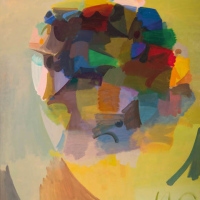15. SAM FULLBROOK

Sam Fullbrooks life and career were full of contradictions, an artist of considerable achievement and professional recognition, yet far from a household name in the minds of most Australians, even those well acquainted with the world of art. His work was distinctive and individual, invariably modest in scale and disarmingly simple in execution. Born in Sydney soon after the Great War, life for a young Fullbrook was a battle through the Great Depression, working as a timber cutter before enlisting in the 2nd Australian Imperial Force at the outbreak of World War II. Fullbrook served in the Middle East and New Guinea before returning to Australia and, on demobilisation, was able to take advantage of a Commonwealth Government retraining scheme to attend the National Gallery of Victoria Art School. He was in good company, with the majority of his fellow students being returned men eager to put the trials of war behind them. On completing their training, fellow students such as Clifton Pugh (1924-90), John Brack (1920-99) and Fred Williams (1927-82) were able to launch new careers in the buoyant post-war world. Fullbrook did start out exhibiting with his peers, but soon chose to head north, interspersing studio work in Sydney with cane cutting and other manual jobs in far north Queensland.
Fullbrooks persona was that of the rugged bushman, taciturn and a bit forbidding in comparison to most artists of the day. He chose not to settle in one place, but moved about the country following new ideas and schemes in the most remote locations. He developed a distinctive style of painting that was at once bold and fresh, yet carefully considered and very deliberate. Robert Juniper (1929-2012) recalled working alongside Fullbrook in Western Australia and was intrigued by his unusual way of approaching a painting. He would contemplate the canvas for some time, working out in his mind just where each stroke would go. Without sketches or drawings, when the idea was fully formed he would, with great care and deliberation, place each sweep of paint onto the canvas. Each mark was a single stroke, with no going back or reworking in any way. The works have an intriguing spontaneity and freshness that belies the deliberation of their making. Fullbrook was intimately attached to his works and always set a substantial sale price.
Looking back over Fullbrooks body of work, there are only a limited range of subjects and motifs, but every work retains its freshness and the clear imprint of the artists hand. Flower studies, still life compositions and informal portraits dominate, as well as outback landscapes and quirky animal and bird subjects. Jockeys, farmers and station hands populate Fullbrooks world, although his portrait of Sir John Kerr failed to make the grade when rejected for hanging at Parliament House as being a caricature. He was much more successful in 1974 when he won the Archibald Prize with his spare portrait of jockey Norman Stephens. The winning work was classic Fullbrook sensitive and understated painting, quite small in scale compared to the huge canvases that would soon come to dominate the nations most prestigious art prize.
Nambucca Heads is Fullbrook at his enigmatic best a work at one moment a landscape, a head study and a bunch of flowers. Strong colour is applied with care and deliberation, yet the overall impression is free and engaging. The tough bushmans persona was balanced with a sophisticated understanding of colour and tone, grounded in his formal art studies and a keen eye that always looked for a fresh and individual take on the world around him.
Gavin Fry BA [Hons] MA MPhil